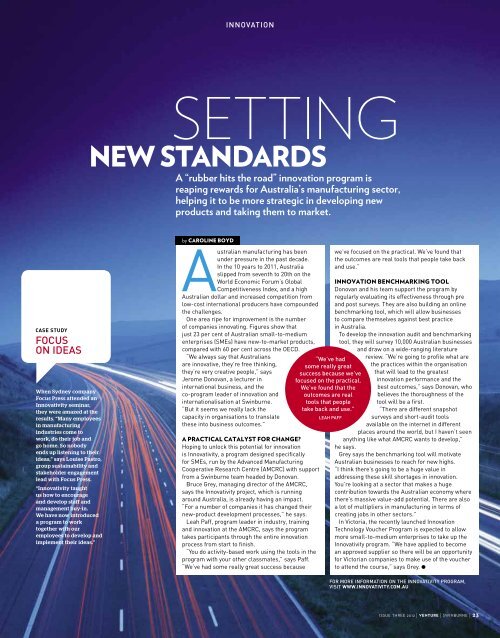View PDF - Swinburne University of Technology
View PDF - Swinburne University of Technology
View PDF - Swinburne University of Technology
You also want an ePaper? Increase the reach of your titles
YUMPU automatically turns print PDFs into web optimized ePapers that Google loves.
innovation<br />
setting<br />
new standards<br />
A “rubber hits the road” innovation program is<br />
reaping rewards for Australia’s manufacturing sector,<br />
helping it to be more strategic in developing new<br />
products and taking them to market.<br />
by caroline boyd<br />
case study<br />
FOCUS<br />
ON IDEAS<br />
When Sydney company<br />
Focus Press attended an<br />
Innovativity seminar,<br />
they were amazed at the<br />
results. “Many employees<br />
in manufacturing<br />
industries come to<br />
work, do their job and<br />
go home. So nobody<br />
ends up listening to their<br />
ideas,” says Louise Pastro,<br />
group sustainability and<br />
stakeholder engagement<br />
lead with Focus Press.<br />
“Innovativity taught<br />
us how to encourage<br />
and develop staff and<br />
management buy-in.<br />
We have now introduced<br />
a program to work<br />
together with our<br />
employees to develop and<br />
implement their ideas.”<br />
Australian manufacturing has been<br />
under pressure in the past decade.<br />
In the 10 years to 2011, Australia<br />
slipped from seventh to 20th on the<br />
World Economic Forum’s Global<br />
Competitiveness Index, and a high<br />
Australian dollar and increased competition from<br />
low-cost international producers have compounded<br />
the challenges.<br />
One area ripe for improvement is the number<br />
<strong>of</strong> companies innovating. Figures show that<br />
just 23 per cent <strong>of</strong> Australian small-to-medium<br />
enterprises (SMEs) have new-to-market products,<br />
compared with 60 per cent across the OECD.<br />
“We always say that Australians<br />
are innovative, they’re free thinking,<br />
they’re very creative people,” says<br />
Jerome Donovan, a lecturer in<br />
international business, and the<br />
co-program leader <strong>of</strong> innovation and<br />
internationalisation at <strong>Swinburne</strong>.<br />
“But it seems we really lack the<br />
capacity in organisations to translate<br />
these into business outcomes.”<br />
A practical catalyst for change?<br />
Hoping to unlock this potential for innovation<br />
is Innovativity, a program designed specifically<br />
for SMEs, run by the Advanced Manufacturing<br />
Cooperative Research Centre (AMCRC) with support<br />
from a <strong>Swinburne</strong> team headed by Donovan.<br />
Bruce Grey, managing director <strong>of</strong> the AMCRC,<br />
says the Innovativity project, which is running<br />
around Australia, is already having an impact.<br />
“For a number <strong>of</strong> companies it has changed their<br />
new-product development processes,” he says.<br />
Leah Paff, program leader in industry, training<br />
and innovation at the AMCRC, says the program<br />
takes participants through the entire innovation<br />
process from start to finish.<br />
“You do activity-based work using the tools in the<br />
program with your other classmates,” says Paff.<br />
“We’ve had some really great success because<br />
“We’ve had<br />
some really great<br />
success because we’ve<br />
focused on the practical.<br />
We’ve found that the<br />
outcomes are real<br />
tools that people<br />
take back and use.”<br />
Leah Paff<br />
we’ve focused on the practical. We’ve found that<br />
the outcomes are real tools that people take back<br />
and use.”<br />
Innovation Benchmarking tool<br />
Donovan and his team support the program by<br />
regularly evaluating its effectiveness through pre<br />
and post surveys. They are also building an online<br />
benchmarking tool, which will allow businesses<br />
to compare themselves against best practice<br />
in Australia.<br />
To develop the innovation audit and benchmarking<br />
tool, they will survey 10,000 Australian businesses<br />
and draw on a wide-ranging literature<br />
review. “We’re going to pr<strong>of</strong>ile what are<br />
the practices within the organisation<br />
that will lead to the greatest<br />
innovation performance and the<br />
best outcomes,” says Donovan, who<br />
believes the thoroughness <strong>of</strong> the<br />
tool will be a first.<br />
“There are different snapshot<br />
surveys and short-audit tools<br />
available on the internet in different<br />
places around the world, but I haven’t seen<br />
anything like what AMCRC wants to develop,”<br />
he says.<br />
Grey says the benchmarking tool will motivate<br />
Australian businesses to reach for new highs.<br />
“I think there’s going to be a huge value in<br />
addressing these skill shortages in innovation.<br />
You’re looking at a sector that makes a huge<br />
contribution towards the Australian economy where<br />
there’s massive value-add potential. There are also<br />
a lot <strong>of</strong> multipliers in manufacturing in terms <strong>of</strong><br />
creating jobs in other sectors.”<br />
In Victoria, the recently launched Innovation<br />
<strong>Technology</strong> Voucher Program is expected to allow<br />
more small-to-medium enterprises to take up the<br />
Innovativity program. “We have applied to become<br />
an approved supplier so there will be an opportunity<br />
for Victorian companies to make use <strong>of</strong> the voucher<br />
to attend the course,” says Grey. l<br />
For more information on the innovativity program,<br />
visit www.innovativity.com.au<br />
issue three 2012 | venture | swinburne | 23

















